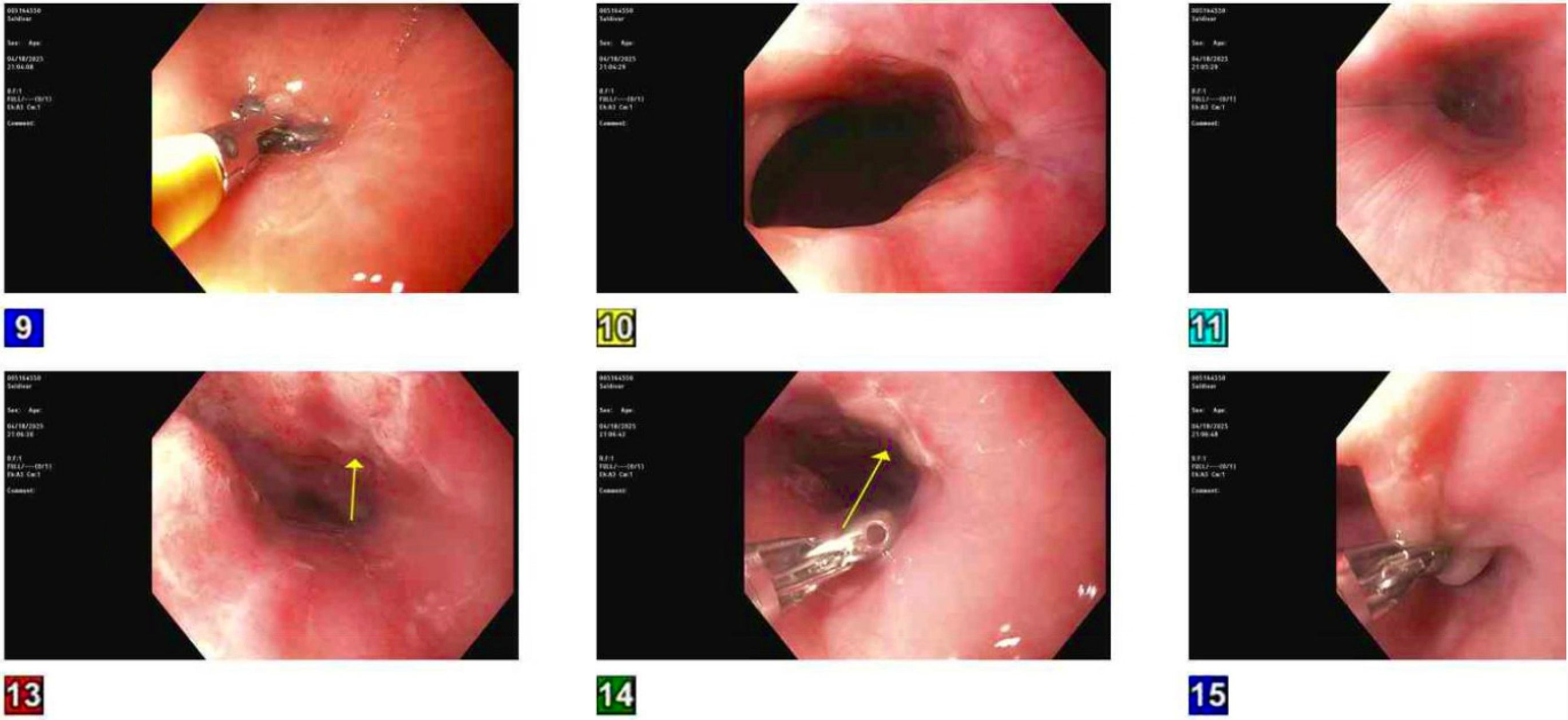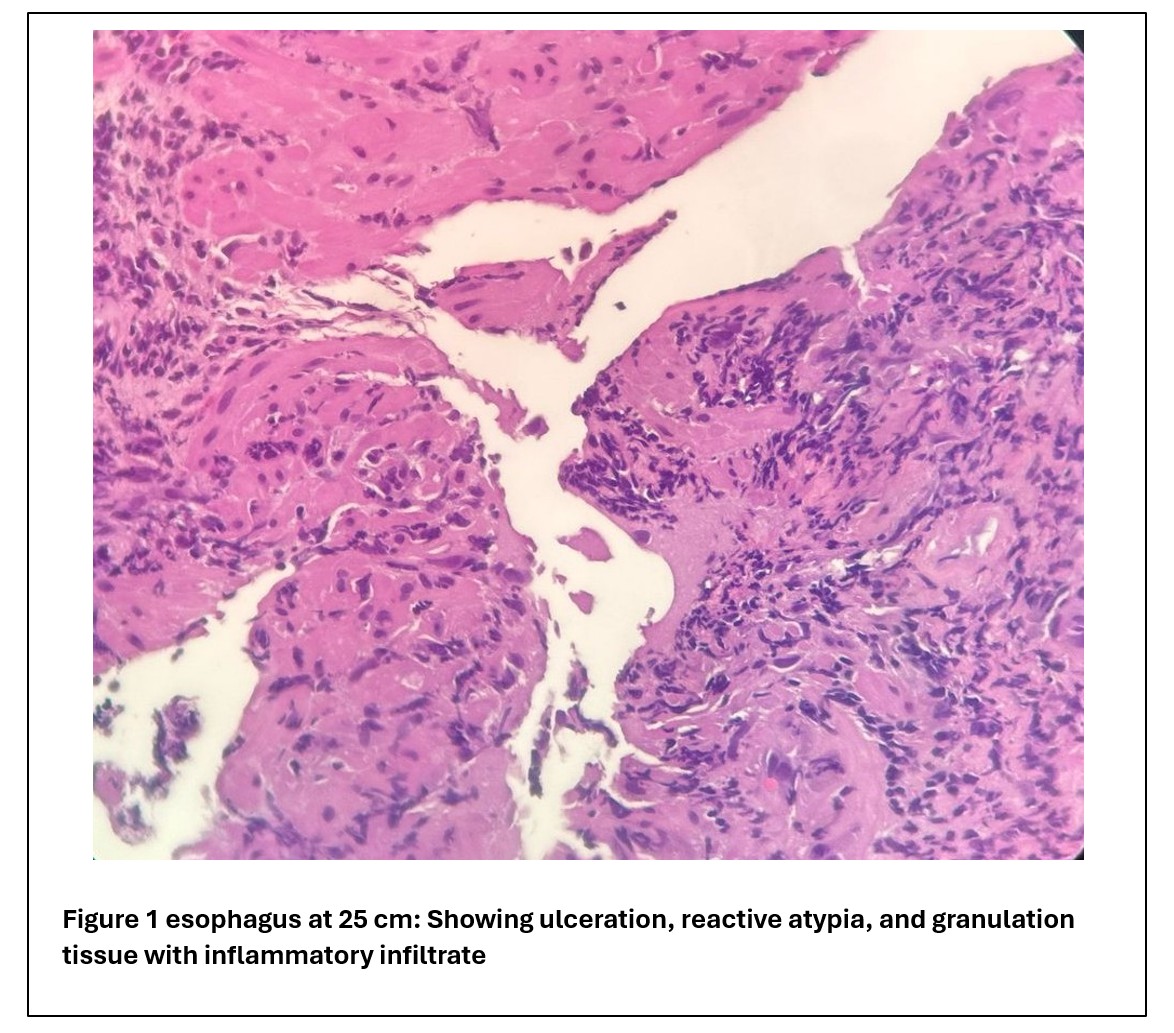Tuesday Poster Session
Category: Esophagus
P4975 - Clindamycin-Induced Pill Esophagitis with Candida Superinfection and Lidocaine-Associated Bradycardia in a Healthy Adult
Tuesday, October 28, 2025
10:30 AM - 4:00 PM PDT
Location: Exhibit Hall
- DP
Deipthan Prabakar, MD (he/him/his)
Texas Tech University Health Sciences Center
El Paso, TX
Presenting Author(s)
Deipthan Prabakar, MD, Vaishnavi Sabesan, MD, Bansi Sutariya, MD, Abirami Rajendiran, MD, Azucena Del Real, MD
Texas Tech University Health Sciences Center, El Paso, TX
Introduction: Pill esophagitis is a well-recognized complication of oral medications such as clindamycin, which can disrupt the esophageal mucosal barrier and predispose to secondary infections. Candida superinfection in immunocompetent hosts remains uncommon. This case illustrates not only that risk but also highlights the potential for systemic absorption of viscous lidocaine across ulcerated mucosa, resulting in transient bradycardia.
Case Description/
Methods: A 20-year-old previously healthy active-duty female presented with severe odynophagia and dysphagia five days after initiating clindamycin 300 mg BID for presumed pharyngitis. She had taken the medication without sufficient water and often before lying down. Symptoms progressed to sharp retrosternal pain with solids and liquids, reduced oral intake, and substernal discomfort. She denied fever, GI bleeding, or prior reflux.
Outside EGD revealed distal esophageal ulcerations with white exudate. Candida esophagitis was suspected, and IV micafungin was initiated. For analgesia, viscous lidocaine was prescribed, after which she developed bradycardia and transient junctional rhythm, attributed to mucosal absorption across ulcerated epithelium. Upon transfer, vitals were stable. Physical exam showed oropharyngeal erythema without thrush. Labs were unremarkable aside from mild hypokalemia. Repeat EGD showed persistent distal ulcerations with white plaques; biopsies revealed Candida albicans and drug-induced mucosal injury. She was transitioned to oral fluconazole and pantoprazole at discharge. Her odynophagia resolved within two weeks.
Discussion: This case highlights three key teaching points: (1) clindamycin remains a common but preventable cause of pill esophagitis, particularly when taken without water or before recumbency; (2) mucosal disruption can predispose to opportunistic fungal infection even in immunocompetent individuals; and (3) viscous lidocaine, though considered safe, may cause systemic cardiotoxicity when absorbed through inflamed or ulcerated mucosa.

Figure: Figure 1: Endoscopic images showing focal erythema and ulceration of the distal esophagus (25–30 cm from the incisors).

Figure: Figure 2: Histopathologic evaluation of the distal esophageal biopsy
Disclosures:
Deipthan Prabakar indicated no relevant financial relationships.
Vaishnavi Sabesan indicated no relevant financial relationships.
Bansi Sutariya indicated no relevant financial relationships.
Abirami Rajendiran indicated no relevant financial relationships.
Azucena Del Real indicated no relevant financial relationships.
Deipthan Prabakar, MD, Vaishnavi Sabesan, MD, Bansi Sutariya, MD, Abirami Rajendiran, MD, Azucena Del Real, MD. P4975 - Clindamycin-Induced Pill Esophagitis with Candida Superinfection and Lidocaine-Associated Bradycardia in a Healthy Adult, ACG 2025 Annual Scientific Meeting Abstracts. Phoenix, AZ: American College of Gastroenterology.
Texas Tech University Health Sciences Center, El Paso, TX
Introduction: Pill esophagitis is a well-recognized complication of oral medications such as clindamycin, which can disrupt the esophageal mucosal barrier and predispose to secondary infections. Candida superinfection in immunocompetent hosts remains uncommon. This case illustrates not only that risk but also highlights the potential for systemic absorption of viscous lidocaine across ulcerated mucosa, resulting in transient bradycardia.
Case Description/
Methods: A 20-year-old previously healthy active-duty female presented with severe odynophagia and dysphagia five days after initiating clindamycin 300 mg BID for presumed pharyngitis. She had taken the medication without sufficient water and often before lying down. Symptoms progressed to sharp retrosternal pain with solids and liquids, reduced oral intake, and substernal discomfort. She denied fever, GI bleeding, or prior reflux.
Outside EGD revealed distal esophageal ulcerations with white exudate. Candida esophagitis was suspected, and IV micafungin was initiated. For analgesia, viscous lidocaine was prescribed, after which she developed bradycardia and transient junctional rhythm, attributed to mucosal absorption across ulcerated epithelium. Upon transfer, vitals were stable. Physical exam showed oropharyngeal erythema without thrush. Labs were unremarkable aside from mild hypokalemia. Repeat EGD showed persistent distal ulcerations with white plaques; biopsies revealed Candida albicans and drug-induced mucosal injury. She was transitioned to oral fluconazole and pantoprazole at discharge. Her odynophagia resolved within two weeks.
Discussion: This case highlights three key teaching points: (1) clindamycin remains a common but preventable cause of pill esophagitis, particularly when taken without water or before recumbency; (2) mucosal disruption can predispose to opportunistic fungal infection even in immunocompetent individuals; and (3) viscous lidocaine, though considered safe, may cause systemic cardiotoxicity when absorbed through inflamed or ulcerated mucosa.

Figure: Figure 1: Endoscopic images showing focal erythema and ulceration of the distal esophagus (25–30 cm from the incisors).

Figure: Figure 2: Histopathologic evaluation of the distal esophageal biopsy
Disclosures:
Deipthan Prabakar indicated no relevant financial relationships.
Vaishnavi Sabesan indicated no relevant financial relationships.
Bansi Sutariya indicated no relevant financial relationships.
Abirami Rajendiran indicated no relevant financial relationships.
Azucena Del Real indicated no relevant financial relationships.
Deipthan Prabakar, MD, Vaishnavi Sabesan, MD, Bansi Sutariya, MD, Abirami Rajendiran, MD, Azucena Del Real, MD. P4975 - Clindamycin-Induced Pill Esophagitis with Candida Superinfection and Lidocaine-Associated Bradycardia in a Healthy Adult, ACG 2025 Annual Scientific Meeting Abstracts. Phoenix, AZ: American College of Gastroenterology.
